$27,000 lost in denied claims. That’s what one mental health practice discovered after analyzing their F32.1 coding errors last quarter. Depression billing errors aren’t just administrative headaches, they directly impact your bottom line.
This comprehensive guide unpacks everything clinicians and billing specialists need to know about the F32.1 code to maximize reimbursement while maintaining compliance.
Who needs this guide?
- Mental health clinicians documenting depression diagnoses
- Medical billers handling behavioral health claims
- Practice managers optimizing revenue cycle processes
- Administrators seeking to reduce claim denials
What you’ll learn:
- Precise clinical criteria for F32.1 diagnosis
- Documentation requirements that satisfy payer scrutiny
- Optimal CPT code pairings for maximum reimbursement
- Practical systems to prevent denials and downcoding
Let’s decode F32.1 to ensure your practice captures the revenue it deserves for providing quality depression care.
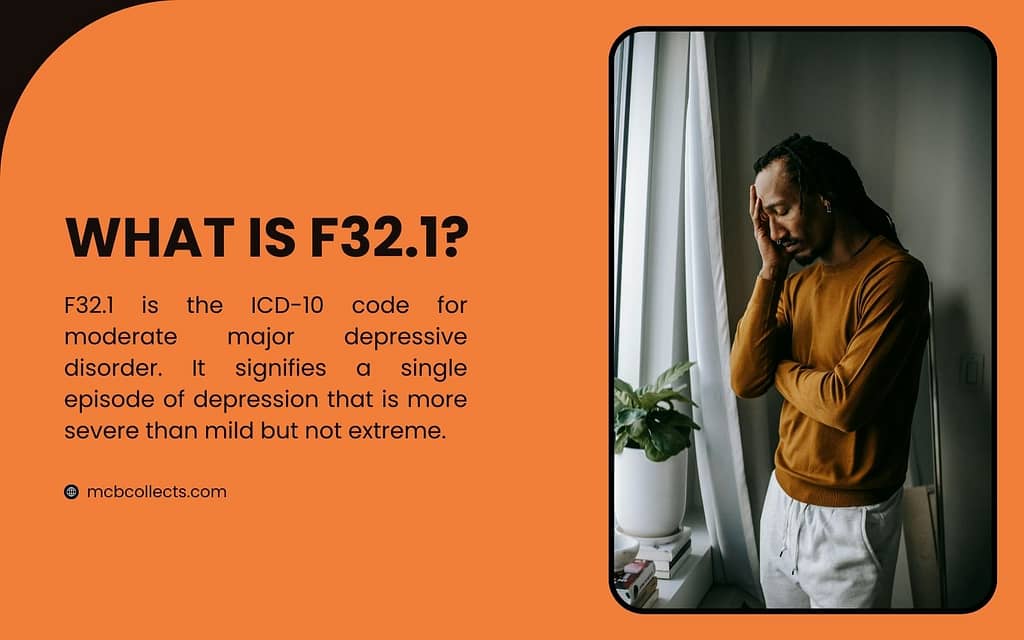
1. Breaking Down the F32.1 Code: What This Depression Diagnosis Actually Means
When you see F32.1 in your medical coding system, you’re looking at “Major depressive disorder, single episode, moderate.” This code sits within the broader F01-F99 mental health category and specifically under F30-F39, which covers mood disorders.
But what does this code actually tell you about the patient’s condition?
- It confirms they’re experiencing a genuine major depressive episode
- It specifies this is a single occurrence, not a recurrent pattern
- It places the severity at moderate, worse than mild depression but not yet severe
Many providers mistakenly use F32.1 as a catch-all depression code. But precision matters here. This specific diagnosis points to a patient who’s struggling significantly but still maintaining some level of function. And that distinction directly impacts both treatment approaches and reimbursement rates.
According to recent statistics, major depressive disorder affects approximately 17.3 million American adults, with a significant percentage falling into this “moderate” classification that F32.1 captures. Proper identification leads to appropriate treatment and (crucially for your practice) proper compensation.

2. How to Confirm You’re Using F32.1 Correctly: Clinical Benchmarks
So when should you actually use the F32.1 code? Patients need to exhibit specific symptoms that meet the threshold for moderate depression. Here’s what to look for:
- Persistent low mood most days
- Noticeably diminished interest in previously enjoyable activities
- Several supporting symptoms like:
- Sleep changes (either insomnia or excessive sleeping)
- Weight or appetite fluctuations
- Slowed movements or agitation
- Energy depletion
- Self-loathing or inappropriate guilt
- Trouble thinking clearly or making decisions
- Thoughts about death (not necessarily suicidal intent)
The “moderate” designation is key. With F32.1, patients typically show more symptoms than mild depression cases but remain functional in some areas of their life. They might struggle at work but maintain family relationships, or vice versa. This moderate impairment distinguishes F32.1 from milder or more severe codes.
Many clinicians find assessment tools helpful in documenting the appropriate severity level. A PHQ-9 score between 10-14 often aligns with the moderate severity captured by F32.1, though clinical judgment remains paramount.
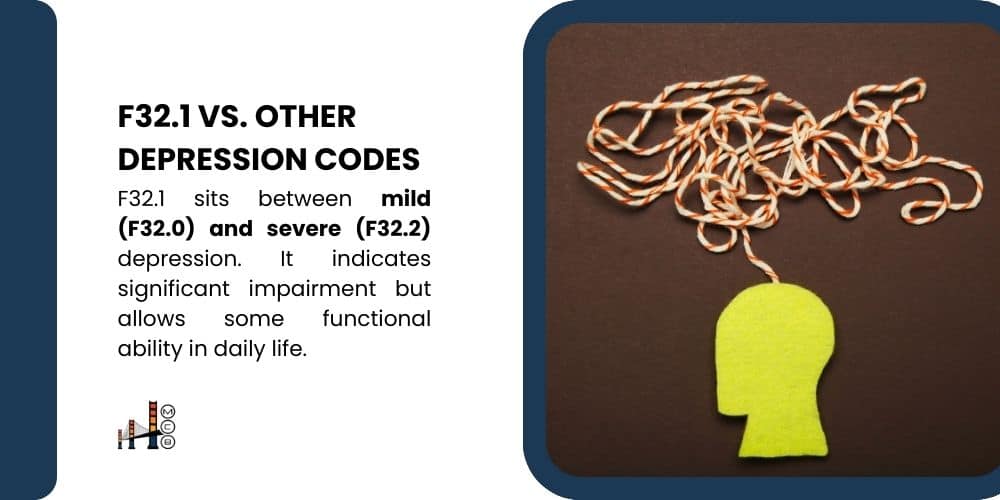
3. Depression Code Comparison: Placing F32.1 in Context
Understanding F32.1 requires seeing how it fits within the broader spectrum of depression codes. This table outlines the key differences:
| ICD-10 Code | Full Description | Clinical Presentation | Functional Impact | Common Treatment Approaches |
| F32.0 | Major depressive disorder, single episode, mild | 2-4 symptoms with minimal intensity | Minor impairment but can fulfill most obligations | Psychotherapy, lifestyle changes, possibly medication |
| F32.1 | Major depressive disorder, single episode, moderate | 5-6 symptoms with notable intensity | Significant struggle but maintaining some function | Psychotherapy, medication commonly required |
| F32.2 | Major depressive disorder, single episode, severe without psychotic features | 7+ symptoms with high intensity | Marked impairment across most areas of functioning | Intensive therapy, medication required, possible hospitalization |
| F32.3 | Major depressive disorder, single episode, severe with psychotic features | 7+ symptoms plus hallucinations, delusions, or stupor | Profound impairment, often unable to maintain basic self-care | Hospitalization often necessary, combined medication approaches |
| F32.4 | Major depressive disorder, single episode, in partial remission | Previously met criteria but now has fewer/less intense symptoms | Improving function but not returned to baseline | Continued treatment to prevent relapse |
| F32.5 | Major depressive disorder, single episode, in full remission | No significant symptoms of depression for at least 2 months | Returned to baseline functioning | Maintenance therapy often recommended |
| F32.8 | Other depressive episodes | Atypical presentations or culture-specific syndromes | Varies based on presentation | Tailored to specific presentation |
| F32.9 | Major depressive disorder, single episode, unspecified | Insufficient information to determine severity | Unknown or undocumented impact | Initial assessment and further evaluation |
| F33.0 | Major depressive disorder, recurrent, mild | Similar to F32.0 but with history of previous episodes | Similar to F32.0 | Similar to F32.0 plus relapse prevention |
| F33.1 | Major depressive disorder, recurrent, moderate | Similar to F32.1 but with history of previous episodes | Similar to F32.1 | Similar to F32.1 plus relapse prevention |
| F33.2 | Major depressive disorder, recurrent, severe without psychotic features | Similar to F32.2 but with history of previous episodes | Similar to F32.2 | Similar to F32.2 plus intensive relapse prevention |
| F33.3 | Major depressive disorder, recurrent, severe with psychotic features | Similar to F32.3 but with history of previous episodes | Similar to F32.3 | Similar to F32.3 plus intensive relapse prevention |
| F33.41 | Major depressive disorder, recurrent, in partial remission | Similar to F32.4 but with history of previous episodes | Similar to F32.4 | Similar to F32.4 with focus on preventing recurrence |
| F33.42 | Major depressive disorder, recurrent, in full remission | Similar to F32.5 but with history of previous episodes | Similar to F32.5 | Similar to F32.5 with focus on preventing recurrence |
This comprehensive view shows why accurately distinguishing between F32.1 and other codes matters. Using the wrong code (even within the same depression family) can lead to denied claims or improper treatment planning. Some insurance plans cover different services based on severity, making precision crucial for reimbursement.
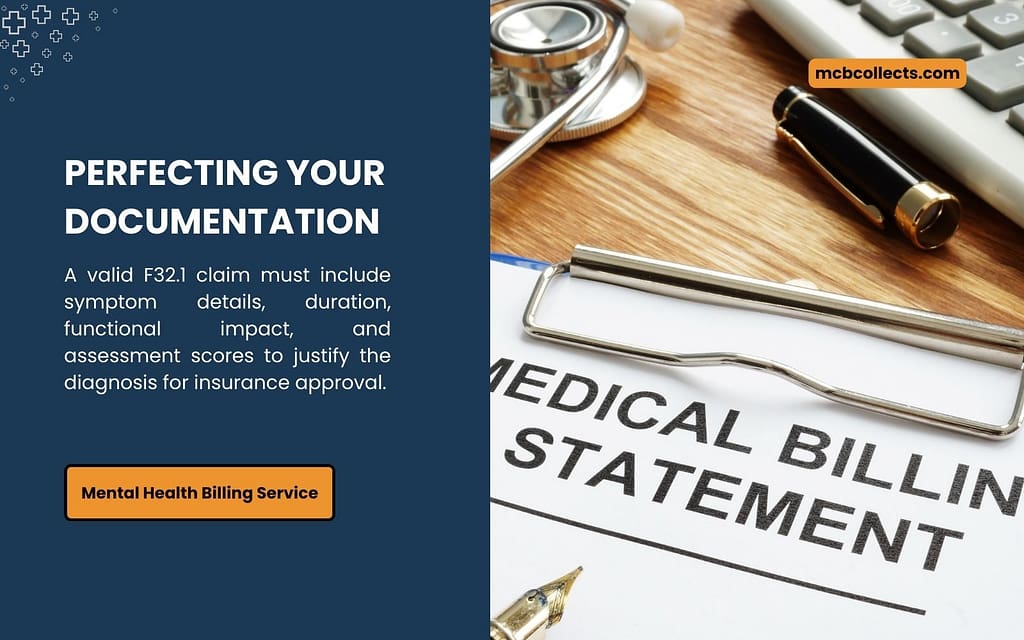
4. Documentation That Supports F32.1 Claims: What Your Charts Must Include
Insurance companies scrutinize mental health claims carefully, particularly for depression. When you assign an F32.1 code, your documentation needs to clearly justify this specific diagnosis. Here’s what your charts must contain:
- Initial Assessment Details
- Specific symptoms observed and reported
- Duration of symptoms (typically at least 2 weeks for major depression)
- Previous psychiatric history (confirming this is a single episode)
- Severity Indicators
- Number of symptoms present (typically 5-6 for moderate depression)
- Specific functional impacts (e.g., “Patient reports missing 2 days of work weekly due to low motivation but maintains basic household responsibilities”)
- Assessment scores if using standardized tools
- Rule-Out Documentation
- Medical conditions considered and eliminated (thyroid disorders, vitamin deficiencies, etc.)
- Substance use assessment
- Bipolar disorder screening
- Functional Analysis
- Work/school performance changes
- Relationship impacts
- Self-care abilities
- Social withdrawal patterns
- Treatment Plan Elements
- Interventions specifically targeting moderate depression
- Goals appropriate to moderate severity
- Expected timeline for improvement
Sample documentation language that supports F32.1 might read: “Patient presents with depressed mood daily for the past month, significant appetite reduction leading to 8-pound weight loss, insomnia averaging 4 hours of sleep nightly, fatigue, and feelings of worthlessness. Patient continues attending work but reports decreased productivity and concentration difficulties. PHQ-9 score of 12 indicates moderate depression severity. Patient denies suicidal ideation, psychotic symptoms, or previous depressive episodes.”
When auditors review your claims, this level of specificity demonstrates why F32.1 (not F32.0 or F32.2) is the appropriate code. Without clear severity documentation, payers often downcode to the lowest severity or deny claims entirely.
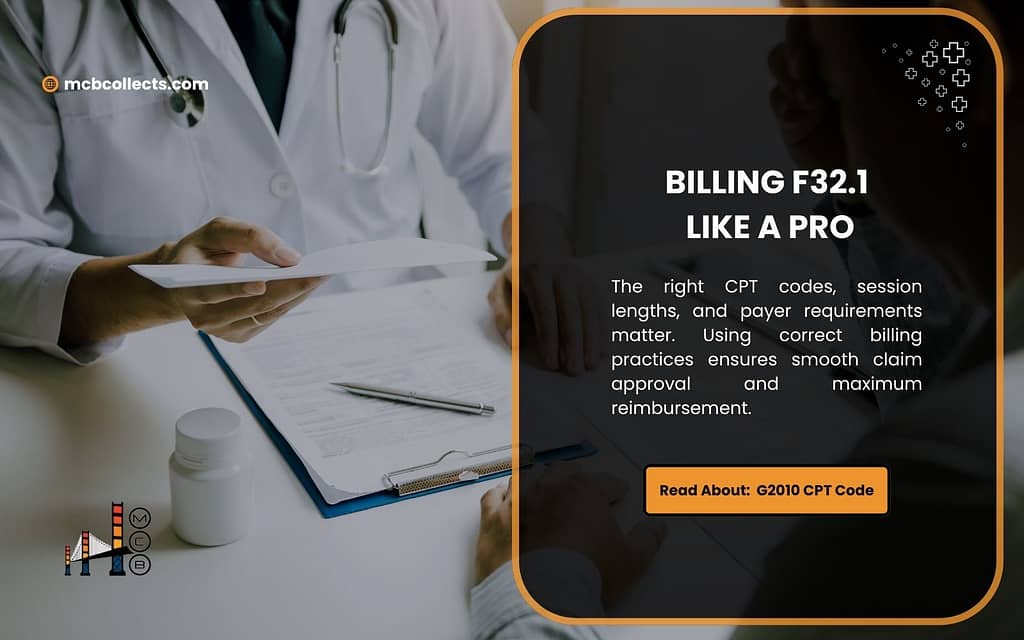
5. The Money Side: Billing Strategies for F32.1 Services
The clinical picture matters, but let’s talk dollars. How do you ensure proper reimbursement when billing for F32.1 diagnoses? Several key factors influence whether your claims get paid in full, get downcoded, or get rejected outright.
Payer-Specific Requirements for F32.1
Different insurance companies have different expectations when it comes to F32.1 claims:
| Payer Type | Common F32.1 Requirements | Frequent Denial Reasons |
| Medicare | Requires clear documentation of functional impairment | Insufficient evidence of moderate severity |
| Medicaid | Often requires use of standardized assessment tools | Missing documentation of previous episodes |
| Commercial | Usually requires detailed treatment plans | Treatment plan doesn’t match moderate severity |
| Managed Care | May limit number of sessions for F32.1 | Prior authorization requirements not met |
One practice we worked with saw their F32.1 claim rejection rate drop by 23% after implementing payer-specific documentation templates. They now maintain a spreadsheet of each payer’s specific requirements and update their EHR templates accordingly.
CPT Code Combinations That Work With F32.1
Your diagnostic code (F32.1) must be logically paired with procedure codes that make sense for moderate depression treatment. Here are service combinations that typically receive favorable reimbursement:
Initial Assessment Services:
- 90791 – Psychiatric diagnostic evaluation
- 90792 – Psychiatric diagnostic evaluation with medical services
Individual Therapy Options:
Crisis Services (when applicable):
- 90839 – Psychotherapy for crisis, first 60 minutes
- 90840 – Each additional 30 minutes of crisis therapy
Family Approaches:
Group Settings:
Psychological Testing (when needed):
- 96130 – Psychological testing evaluation, first hour
- 96131 – Each additional hour
- 96136 – Test administration and scoring, first 30 minutes
- 96137 – Each additional 30 minutes
Telehealth Options:
- 98966 – Telephone assessment, 5-10 minutes
- 98967 – Telephone assessment, 11-20 minutes
- 98968 – Telephone assessment, 21-30 minutes
- Virtual check-in services using codes like G2012 or G2010
For a complete list of options, see our guide to CPT codes for mental health.
Providers sometimes make the mistake of billing services that don’t align with moderate depression. For instance, intensive outpatient program codes might be deemed excessive for F32.1 cases by some payers, while brief therapy sessions might be considered insufficient by others.

6. The F32.1 Reimbursement Roadblocks: Why Claims Get Denied
Even with perfect clinical documentation, F32.1 claims face unique challenges. Here are the top five reasons these claims get rejected or downcoded:
- Medical Necessity Mismatch
- Problem: Documentation doesn’t support the need for the level of service billed
- Solution: Explicitly link symptoms to functional impairments and treatment approaches
- Inconsistent Severity Documentation
- Problem: Some parts of the record suggest mild or severe depression, not moderate
- Solution: Use consistent language throughout all documentation
- Missing Progress Metrics
- Problem: No objective measures showing whether the moderate depression is improving
- Solution: Incorporate standardized assessments at regular intervals
- Treatment Plan Discrepancies
- Problem: Plan targets symptoms not documented or uses approaches inappropriate for F32.1
- Solution: Ensure treatment plans specifically address documented moderate depression symptoms
- Crossover Diagnostic Confusion
- Problem: Record contains contradictory diagnoses (like anxiety with depression features vs. F32.1)
- Solution: Clearly establish primary and secondary diagnoses with supporting evidence for each
One behavioral health practice we consulted with reduced their F32.1 denial rate from 17% to just 4% by implementing a pre-submission checklist addressing these common roadblocks. Their billing staff now reviews each claim against these five potential issues before submission.
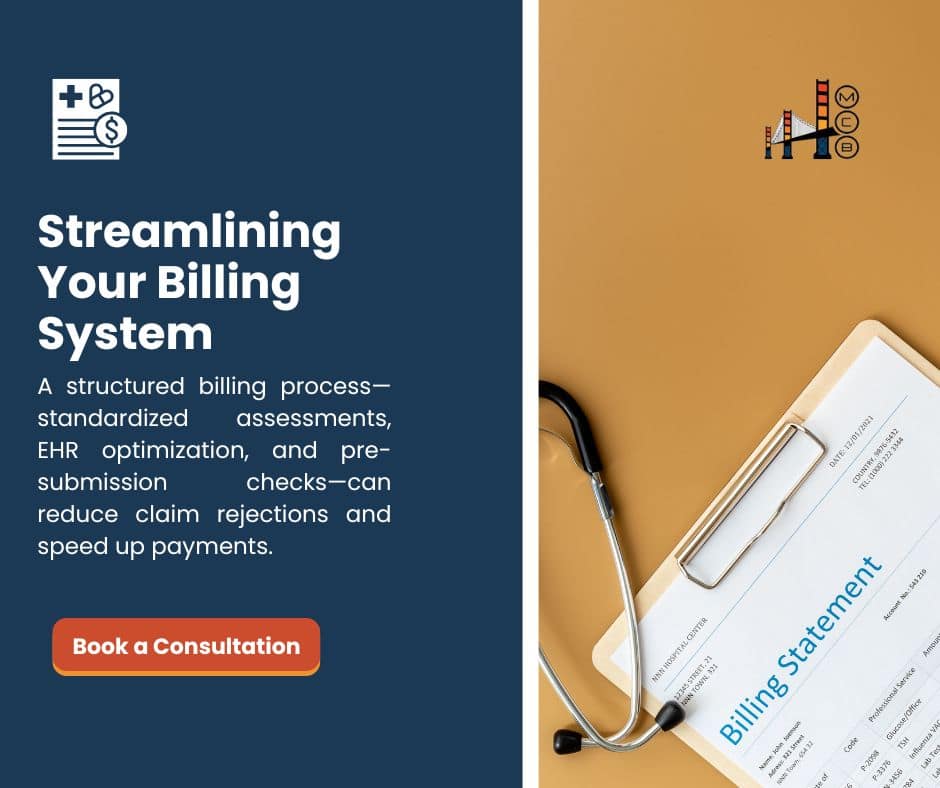
7. Practical F32.1 Billing System: Implementing a Revenue-Protecting Process
Let’s move from theory to practical application. Here’s a five-step system that successful practices use to maximize F32.1 reimbursement:
Step 1: Assessment Protocol Standardization
Develop a consistent approach to depression assessment that automatically captures the elements needed to support F32.1 coding:
- Implement standardized scales (PHQ-9, Hamilton, etc.)
- Create templated functional assessment questions
- Document severity consistently across all provider notes
Step 2: EHR Optimization for F32.1
Configure your practice management system to support proper F32.1 billing:
- Build F32.1-specific templates with required documentation fields
- Set up alerts for missing elements when F32.1 is selected
- Create report filters to identify F32.1 cases for specialized billing review
Step 3: Staff Training on F32.1 Specifics
Ensure everyone touching the patient record understands F32.1 requirements:
- Train clinicians on severity differentiation
- Educate administrative staff on required supporting documentation
- Review real examples of accepted and rejected F32.1 claims
Step 4: Pre-Submission Verification Process
Implement a verification checkpoint before claims go out:
- Create an F32.1-specific claim checklist
- Review documentation against payer-specific requirements
- Verify logical CPT code pairings
Step 5: Outcome Tracking and Process Refinement
Continuously improve your F32.1 billing accuracy:
- Track F32.1 claim outcomes by payer
- Analyze denied claims for patterns
- Adjust documentation practices based on findings
Having trouble implementing these systems? MCB’s comprehensive revenue cycle management services can help you design and implement behavioral health billing processes that protect your revenue while keeping you compliant. Our specialized knowledge of mental health billing can transform your F32.1 reimbursement rates.

8. F32.1 in Practice: Real-World Scenarios and Solutions
Let’s examine three common F32.1 billing scenarios and how successful practices navigate them:
Scenario 1: New Patient with F32.1
The Challenge: Initial visits often lack the comprehensive history needed to confidently assign F32.1.
Solution Approach: One practice we work with implemented a two-visit diagnostic protocol for depression. The first visit includes comprehensive screening and provisional diagnosis, while the second visit finalizes the severity determination with F32.1 when appropriate. This approach increased their clean claim rate by 31%.
Need help optimizing your patient onboarding process? Our medical credentialing services ensure your practice is properly credentialed with all payers for mental health services.
Scenario 2: F32.1 Patient Requiring Extended Treatment
The Challenge: Many payers limit the number of sessions they’ll cover for moderate depression.
Solution Approach: A group practice in the Midwest now conducts formalized reassessments every 6-8 sessions for F32.1 patients, documenting either:
- Continued moderate symptoms justifying ongoing treatment
- Improvement to mild (F32.0) with continued risk factors
- Worsening to severe (F32.2) requiring more intensive intervention
This systematic reassessment approach has extended their average approved treatment course from 10 to 17 sessions.
Scenario 3: Telehealth Services for F32.1
The Challenge: Remote services for depression require additional documentation to support medical necessity.
Solution Approach: A practice specializing in telehealth depression treatment created a specific telehealth addendum for F32.1 patients that documents:
- Access barriers to in-person care
- Specific telehealth adaptations to depression treatment
- Patient engagement metrics during virtual sessions
This approach reduced their telehealth-specific F32.1 denials by 42%.

9. Future-Proofing Your F32.1 Billing: Changes on the Horizon
Mental health billing is evolving rapidly. Here are emerging trends affecting F32.1 billing that forward-thinking practices are preparing for:
- Measurement-Based Care Requirements
- Trend: More payers requiring standardized outcome measures for continued F32.1 treatment
- Preparation: Implement routine measurement tools now, before they become mandatory
- Collaborative Care Incentives
- Trend: Higher reimbursement for F32.1 when treated in collaborative care models
- Preparation: Explore partnerships with primary care providers
- Severity-Specific Treatment Guidelines
- Trend: Payers developing standardized treatment expectations by depression severity
- Preparation: Align treatment plans with emerging guidelines for moderate depression
- Value-Based Payment Models
- Trend: Shift from fee-for-service to outcomes-based payment for depression treatment
- Preparation: Track and document patient improvements using validated measures
Practices that anticipate these changes will maintain steady revenue streams even as F32.1 billing requirements evolve. Consider implementing patient payment services to prepare for increased patient responsibility under new payment models.
Conclusion: Mastering F32.1 Billing for Practice Profitability
The F32.1 code sits at the intersection of clinical accuracy and financial health for behavioral health practices. When properly documented and billed, it ensures appropriate compensation for the skilled care you provide to patients with moderate depression.
Key takeaways for optimizing your F32.1 billing include:
- Document specific symptoms and functional impacts that justify moderate severity
- Standardize assessment approaches across providers
- Match treatment intensity to the moderate severity level
- Implement pre-submission verification processes
- Stay current with payer-specific requirements
By implementing the strategies outlined in this guide, your practice can significantly reduce F32.1 claim denials while maintaining clinical integrity and compliance. The result: more consistent revenue, fewer billing headaches, and more time to focus on patient care.
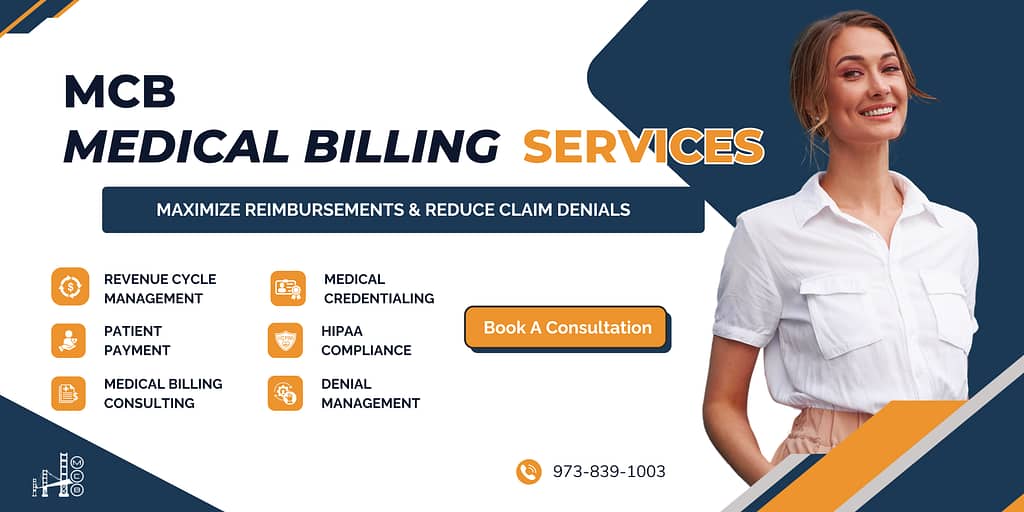
For practices seeking expert guidance on behavioral health billing, MCB’s medical billing consulting services offer specialized support for mental health providers. Our team understands the unique challenges of behavioral health billing and can help your practice implement effective systems for F32.1 and other mental health codes.
Don’t let coding complexities compromise your practice’s financial health. With proper attention to F32.1 documentation and billing practices, you can ensure fair compensation for the valuable depression treatment services you provide.












